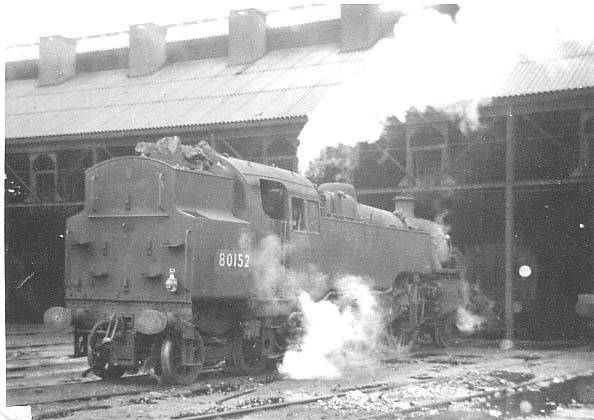- BR standard class 4 tank
Infobox Locomotive
powertype=Steam
name = BR standard class 4 tank
caption = 80152 at Nine Elms MPD, 1965.
designer =R.A. Riddles
builder =Brighton Works (130)
Derby Works (15)
Doncaster Works (10)
builddate =1951 -1956
totalproduction = 155
whytetype = Whyte|2-6-4|T
gauge = RailGauge|sg|al=on|lk=on
leadingsize = convert|3|ft|2|abbr=on|lk=on
driversize = convert|5|ft|8|in|2|abbr=on|lk=on
leadingsize = convert|3|ft|2|abbr=on|lk=on
length = convert|44|ft|10|in|2|abbr=on|lk=on
weight = convert|86.65|LT|lk=on
fueltype =Coal
fuelc
convert|3.5|LT|lk=on
waterc
convert|2000|impgal|L|lk=on
cylindercount = Two
cylindersize = convert|18|x|28|in|cm|abbr=on|lk=on
firearea =
boilerpressure = convert|225|psi|kPa|abbr=on|lk=on
tractiveeffort = convert|25100|lbf|kN|abbr=on|lk=on
powerclass = 4MT
axleloadclass=Route availability 5
roadnumber= 80000 - 80154
preservedunits= 15 (list)
lastrundate=9 July 1967
firstrundate=1951 The British Railways Standard Class 4 tank was a class of steam locomotive, one of the BR standard classes built during the 1950s. They were used primarily on commuter and outer suburban services.
Background
On the nationalisation of
British Railways (BR) in 1948 theLondon Midland Region had a number of ex-London, Midland and Scottish Railway 2-6-4 T and the Western Region a number of "GWR large prairie"2-6-2 T types. Thesetank engine s were particularly suited tocommuter and secondary services. However, particularly in Scotland and the Southern Region, the situation was not so good with large numbers of pre-grouping types struggling on.Design and construction
On the decision to build the BR standards, a series of class four tank engines was ordered, based on the ex-
LMS Fairburn 2-6-4T with some modifications. The Fairburn tanks themselves had been based on theLMS Stanier 2-6-4T which in turn had been based on theLMS Fowler 2-6-4T .Design work was done at Brighton, the overall programme being overseen by
R.A. Riddles . The principal modifications to the Fairburn design involved the reduction of their envelope to enable them to fit into the L1loading gauge . To do this, the tanks and cab were made more curved than the Fairburn design, the Fairburn having a straight-sided tank. The biggest mechanical change was a reduction in cylinder size, also to reduce cross-section, and a corresponding increase inboiler pressure to compensate. Other visible changes include the reintroduction of a fall plate.Most of the class of 155 were built at Brighton, 15 (80000-9/54-8) at
Derby and 10 (80106-15) atDoncaster between1951 and1956 . The first to emerge was 80010 from Brighton in 1951. Fifteen that were due to be constructed in1957 were cancelled due to impendingdieselisation , and the last five would have been too had they not been in an advanced stage of construction when the order came to cancel them.The
BR standard class 4 4-6-0 was essentially a tender engine derivative of the Standard Class 4 tank.No significant modifications were made to the design. The tank vent was found to restrict the driver's vision and was moved further forward from 80059. Initially built with fluted
coupling rod s, these caused problems on other classes and from 80079 plain section coupling rods were substituted.Service
The standard four tanks were allocated to all regions of British Railways, although there were few on the Western. They became particularly associated with the London, Tilbury and Southend Line working commuter services out of London until that was electrified in 1962. They were then gradually displaced to further-flung regions.
Withdrawal
In the 1960s there was a mass withdrawal of steam types. Older types were withdrawn in preference to the Standard Fours which all remained intact until 1964 (apart from one written off in a collision). The final nine were withdrawn from the Southern Region on
9 July 1967 . One Scottish Region example, 80002, remained in Glasgow past the end of steam haulage until 1969 on carriage heating duties.Preservation
No fewer than fifteen Standard Four tanks have survived the cutter's torch. These are:
References
* "A Detailed History of British Railways Standard Steam Locomotives: vol 3 Tank Engine Classes" Paul J Chancellor, R K Taylor (Editor), (December 1997) Railway Correspondence & Travel Society (RCTS) ISBN 0-901115-77-0
External links
* [http://www.semgonline.com/steam/std4t_1.html Southern E group page]
* [http://www.80072.co.uk 80072 www.80072.co.uk]
** [http://www.80072.co.uk/And%20Suckling%20article.htm Standard 4 Tank Engines Andrew Suckling]
Wikimedia Foundation. 2010.
